When Do Morning Glories Bloom: A Guide to Their Blooming Season
Morning glories are a popular flowering plant known for their vibrant colors and unique trumpet-shaped blooms. Many gardeners and flower enthusiasts are curious about when these beautiful flowers bloom and how to care for them.

Morning glories typically bloom in the morning, hence their name, and close in the afternoon or evening. They are annuals, meaning they complete their life cycle in one growing season, and usually bloom from mid-summer to early fall. However, the exact timing of their bloom can vary depending on a variety of factors, including the climate, soil conditions, and the specific species of morning glory.
Despite their delicate appearance, morning glories are relatively easy to care for and can thrive in a variety of environments. They prefer full sun and well-draining soil, and regular watering and fertilization can help promote healthy growth and blooming. With a little bit of attention and care, these stunning flowers can add a touch of beauty and charm to any garden or landscape.
Understanding Morning Glories

Morning glories are a popular flowering plant that are known for their vibrant colors and heart-shaped leaves. They are part of the Ipomoea purpurea species and are often grown as annual vines. In this section, we will provide an overview of morning glories, including their botanical profile, varieties, and colors.
Botanical Profile
Morning glories are a type of climbing vine that can grow up to 15 feet tall. They have heart-shaped leaves that are usually green, but can sometimes have a purplish tint. The flowers of morning glories are trumpet-shaped and can be up to 4 inches wide. They typically bloom in the morning and close up by midday.
Varieties and Colors
Morning glories come in a variety of colors, including blue, red, pink, white, and purple. Some popular varieties include ‘Heavenly Blue,’ which has bright blue flowers, and ‘Scarlet O’Hara,’ which has deep red flowers. There are also bi-colored varieties, such as ‘Blue Picotee,’ which has blue flowers with white edges.
In addition to their colorful blooms, morning glories are also known for their heart-shaped leaves. These leaves can add an interesting texture to a garden or landscape. Overall, morning glories are a beautiful and versatile plant that can add a pop of color to any space.
Planting and Growing Conditions
Morning glories are easy to grow and care for, but they do have specific planting and growing requirements. In this section, we will discuss the soil and light requirements, watering and fertilization, as well as support and space considerations.
Soil and Light Requirements
Morning glories prefer well-drained soil that is rich in organic matter. The soil pH should be between 6.0 and 7.5. These plants require full sun, at least six hours of direct sunlight per day, to flower and thrive. If the soil is too acidic, adding lime will help raise the pH level.
Watering and Fertilization
Morning glories require regular watering, especially during the dry summer months. Water the plants deeply once a week, making sure the soil is moist but not waterlogged. Too much water can lead to root rot. Fertilize the plants once a month with a balanced fertilizer that contains equal amounts of nitrogen, phosphorus, and potassium.
Support and Space
Morning glories are climbing vines that need support to grow and bloom. They can be trained to climb a fence, trellis, or other support structure. If planting morning glories in a container, make sure the container is large enough to accommodate the plant’s growth. Space the plants at least 6 inches apart to give them room to spread out.
In summary, morning glories require well-drained soil, full sun, regular watering, and monthly fertilization. They also need support to climb and space to grow. By following these planting and growing conditions, you can enjoy beautiful morning glory blooms all summer long.
Optimal Bloom Times

Morning glories are beautiful and vibrant flowers that bloom during the summer months and early fall. However, the exact timing of their bloom depends on several factors, including seasonal patterns and weather conditions.
Seasonal Blooming Patterns
Morning glories typically bloom during the summer months, from June to August. However, the exact timing of their bloom can vary depending on the location and climate. In warmer regions, morning glories may bloom earlier, while in cooler regions, they may bloom later.
Furthermore, morning glories are known to bloom in response to changes in daylight. As the days get longer during the summer months, morning glories are triggered to bloom. However, as the days start to get shorter in the fall, morning glories will stop blooming and eventually die off.
Temperature and Weather Influence
Temperature and weather also play a significant role in the blooming of morning glories. These flowers prefer warm temperatures and will not bloom if temperatures are too cold. Frost can be particularly damaging to morning glory blooms, causing them to wilt and die.
In addition, morning glories require adequate moisture to bloom. If there is a lack of rain or humidity, morning glories may not bloom as well as they should. On the other hand, excessive rain or moisture can also be detrimental to morning glory blooms, causing them to rot or develop fungal diseases.
In conclusion, morning glories bloom during the summer months and early fall, with the exact timing dependent on seasonal patterns and weather conditions. They require warm temperatures and adequate moisture to bloom properly, while frost and excessive moisture can be damaging to their blooms. By understanding these factors, gardeners can ensure optimal blooming times for their morning glories.
Maintenance and Care

Morning glories are relatively low-maintenance plants that require just a bit of attention to thrive. Proper maintenance and care can help ensure that your morning glories bloom beautifully and abundantly.
Pruning and Training
Pruning and training are essential for morning glories to grow and bloom properly. These plants tend to grow quickly and can easily become tangled or unruly, so regular pruning is necessary to keep them in check. Deadheading, or removing spent blooms, can also help encourage more blooms to form.
To train morning glories to grow in a specific direction, use a trellis or other support structure. This will help keep the vines off the ground and prevent them from becoming tangled or damaged.
Managing Pests and Diseases
Morning glories are generally resistant to pests and diseases, but they can still be vulnerable to certain issues. Common pests that may affect morning glories include aphids, spider mites, and whiteflies. These pests can be controlled with insecticidal soap or neem oil.
Diseases that may affect morning glories include fungal leaf spot and powdery mildew. To prevent these issues, avoid overhead watering and ensure good air circulation around the plants. If disease does occur, remove infected plant material and treat with a fungicide if necessary.
Overall, taking care of morning glories is relatively simple and straightforward. With a bit of pruning, training, and pest management, these beautiful flowers can thrive and bloom all season long.
Environmental Impact and Considerations

Morning glories can have both positive and negative impacts on the environment. It is important to consider these impacts when deciding whether or not to plant morning glories in your garden.
Invasive Nature and Control
Morning glories are known for their invasive nature and can quickly take over an area if not properly controlled. They are considered a weed in many areas and can be difficult to remove once established. It is important to monitor morning glory growth and take action to prevent it from spreading beyond desired areas.
One way to control morning glories is to regularly remove any self-seeding plants before they have a chance to establish themselves. Another option is to use physical barriers, such as landscape fabric or mulch, to prevent morning glory seeds from germinating.
Attracting Wildlife and Biodiversity
Despite their invasive nature, morning glories can also have positive impacts on the environment. They are known to attract pollinators, such as bees and butterflies, which can help increase biodiversity in the area.
Morning glories can also provide charm and show in a garden, especially when grown on trellises or other structures. They are low maintenance and can thrive in a variety of conditions, including strong winds and tropical climates.
It is important to note that some species of morning glories, such as the Ipomoea violacea, are poisonous and should be avoided. Overall, morning glories can be a beautiful addition to a garden if properly managed and monitored.
Frequently Asked Questions
What month do morning glories typically start blooming?
Morning glories typically begin to bloom in late spring or early summer, depending on the climate and location. In warmer areas, they may start blooming as early as May, while in cooler regions, they may not start until June or July.
How can gardeners encourage their morning glories to bloom?
To encourage morning glories to bloom, gardeners should ensure that the plants receive plenty of sunlight and are grown in well-drained soil. Fertilizing with a balanced fertilizer can also help promote blooming. Deadheading spent flowers can also encourage more blooms.
Do morning glories return annually or are they replanted each season?
Morning glories are typically grown as annuals, meaning they complete their life cycle in one growing season and do not return the following year. However, in warmer regions, they may reseed themselves and return as volunteers the following year.
What are the sun requirements for morning glories to thrive?
Morning glories require full sun to thrive and produce abundant blooms. They should be planted in a location that receives at least 6-8 hours of direct sunlight per day.
Can morning glories be considered invasive, and if so, how to manage them?
Morning glories can be considered invasive in some areas, as they have a tendency to self-seed and spread quickly. To manage their growth, gardeners can remove spent flowers before they have a chance to set seed. Alternatively, they can grow morning glories in containers or in designated areas where their growth can be controlled.
What are the different color varieties of morning glories?
Morning glories come in a wide range of colors, including shades of blue, purple, pink, red, and white. Some varieties also have variegated or bi-colored blooms. Popular cultivars include ‘Heavenly Blue’, ‘Grandpa Ott’s’, and ‘Scarlett O’Hara’.

